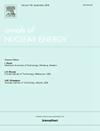蒸汽发生器管裂纹扩展的数字孪生模型生成:方法与实现
IF 2.3
3区 工程技术
Q1 NUCLEAR SCIENCE & TECHNOLOGY
引用次数: 0
摘要
蒸汽发生器管内裂纹扩展是影响核电站安全运行的关键因素。裂纹扩展行为的准确预测对于有效的设备健康监测和维护至关重要。提出了数字孪生技术在核电厂实施的基本框架和关键技术。介绍了一种将实验数据与扩展有限元模拟结果相结合的蒸汽发生器管裂纹扩展数字孪生模型生成技术。采用粒子滤波法和强化学习法分别对裂纹扩展预测的优缺点进行了评价。将实验数据和扩展有限元仿真数据结合到模型训练过程中。结果表明,两种数字孪生模型生成技术具有不同的适用条件和较高的精度。该研究可为蒸汽发生器管道健康监测提供新的见解和技术途径。本文章由计算机程序翻译,如有差异,请以英文原文为准。
Digital twin model generation for crack propagation in steam generator tubes: Methods and implementation
Crack propagation in the steam generator tubes are critical factor influencing the safe operation of nuclear power plants. Accurate prediction of crack growth behavior is vital for effective equipment health monitoring and maintenance. A fundamental framework and key technologies for the implementation of digital twin technology in nuclear power plants were presented in this study. And a novel crack propagation digital twin model generation technique for steam generator tubes was introduced, which integrates experimental data with extended finite element simulation results. Particle Filter method and reinforcement learning were conducted to evaluate respective strengths and limitations in crack propagation prediction. Both experimental data and extended finite element simulation data were incorporated into the model training process. The results demonstrated that both digital twin model generation techniques have distinct applicability conditions and high accuracy. This study could provide new insights and technological approaches for the health monitoring of steam generator tubes.
求助全文
通过发布文献求助,成功后即可免费获取论文全文。
去求助
来源期刊

Annals of Nuclear Energy
工程技术-核科学技术
CiteScore
4.30
自引率
21.10%
发文量
632
审稿时长
7.3 months
期刊介绍:
Annals of Nuclear Energy provides an international medium for the communication of original research, ideas and developments in all areas of the field of nuclear energy science and technology. Its scope embraces nuclear fuel reserves, fuel cycles and cost, materials, processing, system and component technology (fission only), design and optimization, direct conversion of nuclear energy sources, environmental control, reactor physics, heat transfer and fluid dynamics, structural analysis, fuel management, future developments, nuclear fuel and safety, nuclear aerosol, neutron physics, computer technology (both software and hardware), risk assessment, radioactive waste disposal and reactor thermal hydraulics. Papers submitted to Annals need to demonstrate a clear link to nuclear power generation/nuclear engineering. Papers which deal with pure nuclear physics, pure health physics, imaging, or attenuation and shielding properties of concretes and various geological materials are not within the scope of the journal. Also, papers that deal with policy or economics are not within the scope of the journal.
 求助内容:
求助内容: 应助结果提醒方式:
应助结果提醒方式:


